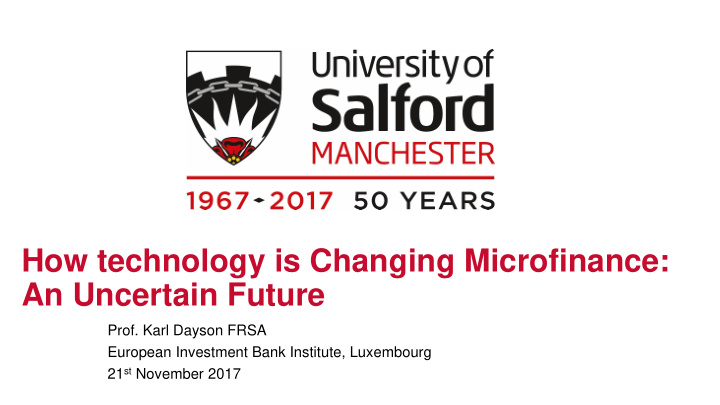



How technology is Changing Microfinance: An Uncertain Future Prof. Karl Dayson FRSA European Investment Bank Institute, Luxembourg 21 st November 2017
About the Presenter • PhD on the demutualisation of building societies and creation of new mutuals in the UK • Worked for 20 years on financial inclusion, financial services and institutions • Helped create 11 community finance firms • Drafted European Code of Conduct for Microcredit Providers on behalf of the EC • Co- author of ‘Management Information Systems for Microfinance’ (2015)
Microfinance • Usually associated with loans to deprived communities in the developing world. • Long history of microfinance in Developed World. Private sector & linked to public policy (financial inclusion and SME) • EU defines as loans less than € 25,000 for economic purposes • Some debate about whether personal finance smoothing should be included. • ResponsAbility 2017 Outlook broadened definition to MSME lending. • Time to broaden the definition to include Developed World
FinTech • Fintech is a portmanteau of financial technology that describes an emerging financial services sector in the 21st century. Originally, the term applied to technology applied to the back-end of established consumer and trade financial institutions. Since the end of the first decade of the 21st century, the term has expanded to include any technological innovation in the financial sector, including innovations in financial literacy and education, retail banking, investment and even crypto-currencies like bitcoin. http://www.investopedia.com/terms/f/fintech.asp#ixzz4lgfbGriq
Types of Fintech • MIS • Mobile phone banking • Peer-to-peer • Blockchain • Big Data, credit score and IoT • Machine Learning & AI
Fintech in ‘microfinance’ space • BKash (Bangladesh) transaction services • M-Peso and M-Shwari in Kenya for m-payments and m-credit • BC Finance (Myanmar) and Infoteria (Japan) testing Blockchain • Peer-to-Peer Lending Club with CDFI in California. Thin Cats with ART, Birmingham, UK.
Why Does Fintech matter now? 1. Crises of legitimacy for microfinance providers. 2. Marginalisation of community finance in USA & UK should be a warning (changes in relationship banking & declining market share) 3. Shift in cost basis results in undercutting 4. Innovators are seen as the good guys (reputational damage) 5. Regulation favours tech firms over finance firms 6. Tech undercuts moral purpose of microfinance firms 7. Implementation challenges
Crises of legitimacy • Andhra Pradesh microfinance crisis • Bateman criticism • A crisis of governance (Grameen) • Relevance in era of growing urbanisation & emerging middle- class.
Growth of Microfinance in Europe (Source: EIF Working Paper 2016/35)
European Microfinance (50 MFIs tracked) (source: EIF Working Paper 2016/37)
Marginalisation of Community Finance in USA and UK
Comparing New Entrants to Microfinance Providers Value of funds disbursed by crowdfunding platforms & other providers (£mn) 700 600 500 400 300 200 100 0 2011 2012 2013 2014 P2B P2P Equity Reward CDFI Credit union
2017 (Q2) 2016 (Q2) FDIC Insured 5787 6058 Credit Unions 5812 5906
Shift in Cost Basis BP cost advantage P2P over banks (US) P2P Branch Collection/billing Origination Marketing Other Bank 0 100 200 300 400 500 600 700 800
Bank Branches: A Strange Death? FDIC Insured banking offices per 10,000 2.82 2.65 2.52 2.46 2.1 1.55 1.35 1.23 1.22 1936 1946 1956 1966 1976 1986 1996 2006 2016 FDIC Insured banking offices per 10,000
Innovators are seen as the good guys • Lead by powerful brands (Apple - ApplePay) • Not the banks and not responsible for the Crash • Serendipity of mobile phones & an undeveloped banking sector in Asia & Africa. • Limited evidence of poor lending decisions • High cost payday lenders are seen as part of financial sector and not tech sector. • Governments begin to look to tech companies to solve financial inclusion problems. e.g. UK
Regulation favours techs • No legacy systems so lower costs. • GAFA are highly capitalised so could create popular banks on the back of their brands • Rising cost of regulatory compliance favours those with automated systems that produce regular, consistent and reliable data. • APR caps favour those that can keep costs down. • Restrictions on cash transactions favours innovators.
The dark side of Fintech • Longstanding concern about digital divide & financial literacy • Automating processes results in cost cutting and by extension job losses. What microfinance investor wants that? • It could address IR costs, but requires more data from vulnerable clients • Big data usage to create new credit scoring systems could individualise the process, resulting in targeting clients must likely to repay. • Higher fees for those that are most vulnerable
Implementation • Costly • Need expertise – complex field • Select delivery mechanism: white label, direct or gold label • Have to work in partnership • Investors are reluctant to fund the transition • No guarantee of success. Transition is high risk
What does this mean for microfinance? 1. Fintech is an existential crisis for microfinance. 2. A collapse in distance changes notion of community & mutuality 3. Fintech offers huge potential cost savings over legacy systems 4. Evidence from USA and UK suggest that new entrants offer a service people want. 5. Moral case for microfinance has been diluted by need for sustainability.
Conclusion Four futures for microfinance: 1. Chase sustainability & go up-market (incorporation) 2. Gradual decline & growing irrelevance (marginalisation) 3. Focus on those most at risk & least access to internet (residualisation) 4. Greater collaboration around tech & processes, with enhanced moral purpose to offset big data risks (reawakening)
Thank You For more information contact: k.t.dayson@salford.ac.uk
Recommend
More recommend